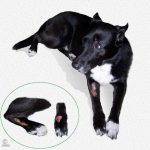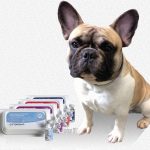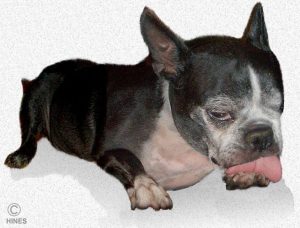Why Is My Dog Licking Its Paws So Much?
Ron Hines DVM PhD
 Another article on lick-related issues
Another article on lick-related issues
 Our feet when we lick too much
Our feet when we lick too much
 How about Cytopoint® or Apoquel®?
How about Cytopoint® or Apoquel®?
Why Does My Dog Do This?
That is one of the most common question that dog owners ask their veterinarians. Licking and fretting over their paws is part of a dog’s normal grooming behavior. It is part and parcel of their subconscious body language – just like tapping your feet or playing with your hair. It only becomes a problem when your pet does it in excess or carries it to the extreme.
When your pet licks and nibbles its front paws and forearms compulsively, it is either due to paw irritation or it has become a way for your pet to deal with boredom or stress or both. A few cases are quite easy for your veterinarian to solve – a broken toenail, a splinter, a bacterial or fungal infection, contact sensitivities. But most cases are complicated, complex and exasperating, without simple solutions.
Some cases are a prelude to generalized itchy skin problems; but many times they never progress beyond your pet’s toes.
To Answer Why, We Need To Sort Out The Clues:
Your Dog’s Breed and Temperament
Certain breeds seem to suffer from paw licking issues more than others. Among those breeds are Labrador retrievers, terriers of all kinds, poodles, chihuahuas and Maltese. White and blond-haired breeds may not be more prone to paw licking, but when they do have the problem, their saliva discolors their paw fur and makes it more apparent. Compulsiveness seems to be the common thread, and it is often linked to your pet’s individual genetics.
Highly alert, hardworking breeds are more likely to relieve stress and boredom through over grooming and paw licking – breeds like greyhounds, dalmatians, and cattle dogs.
At What Point In Your Dog’s Life Did The Problem Begin?
Paw licking problems run in dog families (lines). If your pet’s parents or siblings shared this problem, it is more likely to be a family trait than an acquired issue. Dogs in this group often began to lick their paws in their second year. They often cannot be entirely cured – but many things can be done to make the behavior less of a problem.
Dogs that began the activity later in life are more likely to respond to environmental, lifestyle and dietary adjustments.
The Context Of The Licking And Chewing – When Does Your Pet Do It?
If your dogs worries its paws only in one or two situations – for example when it is left alone, during certain times of the day or after visiting the groomers – you have a greater chance for modifying that behavior. Many of those solutions hinge on environmental enrichment which I’ll get to later.
Just One Paw, Two or Four?
When only one paw of your dog is being licked, the problem is almost always within that paw. It could be a broken toenail or one worn too short or left so long that it curled. It could be a thorn or splinter in the pad or a burr lodged between the toes. It could be a foot pad cut by some sharp object. It could be a bone in the foot that had been fractured or arthritis most prominent in a single joint. In older dogs, it might be a skin tumor. It could be that an interdigital (between the toes) abscess has formed on that foot. Considerably rarer, it is due to a lack of normal feeling in the foot subsequent to nerve damage or heredity. (read here)
Occasionally, a dog will develop a lick granuloma (a raw area with raised edges) on the upper surface of its paw. You can read more about that problem and how one might deal with it here.
An Otherwise Clean Bill Of Health?
It is always wise to be sure that a paw-licking problem in your dog is not part of a broader-based health issue(s). Ear infections, hair loss, musty odor (seborrheic dermatitis), discharge from the eyes, sneezing and rashes can indicate that more than your pet’s paws are involved. They can be signs that your dog is itchy – something often related to allergies, fleas or contact sensitivities. So, your veterinarian might suggest a general health screen or profile that includes a group of blood tests and microscopic skin scraping examinations to rule out a broader-based problem. That is particularly true when simple methods of control have failed or the problem reoccurs multiple times.
What Are The Triggers That Start My Dog’s Licking Cycles?
Keep a diary and record things that appear to make your pet’s problem worse. Is this a seasonal problem? Does the dog worry its paws mostly when you are away? Does it usually occur after the dog has been groomed? Did the problem begin suddenly and, if so, what events preceded it? Does the problem appear worse after the pet has been out in the yard? Is it more common after periods of rain? Does it get better when you and your pet are visiting a different location? Has your pet recently gained or lost substantial weight? Has its general activity level changed? Does it limp or appear stiff? If the problem occurs during your absence, does destructive or bizarre behavior also occur during those times too?
What Tests Might My Veterinarian Perform To Determine The Cause?
Veterinarians have a myriad of sophisticated tests available to them that make it considerably easier than it once was to diagnose medical problems. But when it comes to paw licking, the oldest tests of them all, a careful physical examination of your dog and a good account of your pet’s history, are still the most important. In over 80% of paw-licking dogs, those sophisticated tests will be normal. Nevertheless, blood tests, microscopic skin scrapings and perhaps even x-rays need to be included in most workups because the 20% or so of the cases in which they reveal something are the 20% that can be the easiest to treat successfully. Those are dogs with sluggish thyroid glands (hypothyroidism), dogs with certain autoimmune disorders (pemphigus), those with sarcoptic mange or demodectic mange, those with fungal skin infections or uncomplicated bacterial infections. Through the process of eliminating all those causes – as well as ending flea exposure – it leaves boredom, compulsive behavior, anxiety or allergies as the most likely underlying cause (in quite a few dogs more than one cause underlies the licking problem). When it comes to allergies, blood-based allergy testing is of very little help in determining if allergies really the underlying cause. That is because these tests give too many false-positive and false negative results. (read here) Just putting your dog on one of the allergy-relief hydrolyzed protein diets for a month or two is a considerably better test.
Tell Me More About The Common Causes:
Boredom And Individual Temperament
Self-grooming and snoozing are the natural ways that dogs pass their time when they are not concentrating on other matters. Their ancestors, the wolves, spent most of their time hunting for food, interacting with their pack and cleansing their bodies after the hunt. Only 3-14% of their hunts are successful, so they do not stay in one place long. About thirty-five % of their time is spent traveling and about half of their day keeping an eye out for food. Your dog has it easy. It has so much more idle time on its hands than its ancestors ever did. You will need to fill that extra time with non-destructive activities if you want your dog to remain healthy. One way is to make mealtime more challenging with puzzle feeders, multiple small meals or feeders that dispense only small portions at a time. A whole science has sprung up that focuses on ways to relieve the boredom and stress in dogs and cats. It is called environmental enrichment. All environmental enrichment relies on distraction, complicating the simple repetitive activities of daily life, playing games, interacting with other family members and pets and positive reinforcement techniques. Read suggestions online as to how to create a more stimulating, distracting environment for your dog.
Your pet’s individual temperament and frustration level also has a lot to do with many paw-licking problem. High-strung, active breeds just require more stimulating activities during the day than more laid-back individuals or breeds. But the opposite can also be true. Dogs that are inactive for any reason spend more time grooming themselves. Mobility issues that occur as the result of arthritis, obesity or the lower activity and metabolism levels of hypothyroidism can also lead to paw licking.
Allergies – Canine Atopy
There is a practical way to separate boredom and anxiety-based psychological reasons for licking from allergic causes. I never suggest a dog receive long-term medications without a good reason. Zoetis’ Cytopoint® monthly injectable medication was designed primarily to target an itch messenger compound (IL31) that plays a large part in itch sensation. If a single test injection of this medication does not decrease licking of the area rapidly (within a week), your dog’s problem is probably psychological rather than a true itch. You can read more about Cytopoint® here. I would caution you against giving this drug or Apoquel® as a test for the cause of a simple licking problems if your dog is over 5 years old. If Cytopoint® does stop the problem, you have to decide if the licking is a serious enough issue for your dog and you to warrant the risks that all powerful medications entail.
I suspect that allergies top the list of the physical reasons why dogs lick their paws excessively. The most common of those allergies are to the things that your dog inhales – probably the same ones that would cause hay fever in people. Grass pollens are high on the list, as are mold spores, weed and tree pollen. Things found indoors, such as dust mites, cockroaches and cat dander can be culprits too. When allergies are the root cause of a paw-licking problem, over time, the dog’s whole body, particularly its flanks tend to become itchy as well. Other skin-related problems, such as a musty odor, hair loss, excessive shedding, ear infections and matter at the inner corners of your dog’s eyes are likely to occur as well. Although these problem often begin seasonally, with time they usually progress to a year-round problem. You can read more about allergy problems in dogs here.
Food allergies are much rarer than inhalant allergies in in dogs and cats. When food allergies actually are present in dogs, gastrointestinal signs (diarrhea) are a large part of the issue. After all, the gastrointestinal tract is the first part of the body exposed to them. A lot of attention is paid to food allergies in dogs because marketers and veterinarians push these more profitable “hypoallergenic” diet lines. They are also popular because providing them to your pet is a low-effort, easy thing to do with little or no downside. That said, there is no harm in trying a month or two of hypoallergenic diet diet and see if it actually has any positive effects.
Blood-based allergy tests are marketed to determined if your pet is “sensitive” to perhaps a specific meat protein or a grain product. They are notoriously inaccurate, missing a few specific allergens but falsely reporting others that really do not exist.
Contact Sensitivities and Irritants
Explore the possibility that your pet might be allergic to substances that end up on its paws. Is the problem worse when it returns from the yard or a walk? Does the problem go away while the dog is away from your home for extended periods? Does a foot rinse basin or pre-moistened, hypoallergenic, non-scented skin wipes alleviate or reduce the problem? Did the problem begin when you started using some cleaning or odor control product or moved to a new residence? Toy breeds, perhaps because of their temperament, seem particularly prone to this problem. Persistently wet paws, either from a damp environment, licking or from excessive sweating, will eventually cause paw infections and inflammation.
Fleas
Fleas can be the underlying cause. Some veterinarians might put them at the very top of the list. A flea problem is sometimes misdiagnosed as a “staph” problem. When staphylococcus are isolated from raw areas on your dog’s feet they are almost always the result, not the cause, of the foot or skin problem. Staph, particularly two called S. intermedius and S. pseudintermedius normally reside on your dog’s body. Healthy skin barriers keep them from causing mischief. (read here) But when a dog over licks, it keeps the area damp and disrupts those skin barriers as it licks and chews. That gives these staph bacteria opportunities to invade the deeper layers of your dog’s skin and subcutaneous tissue causing infections and the boils that sometimes appear between your pet’s toes. Read more about staph infections further down in this article. Fleas themselves are rarely found on the paws, they tend to prefer the dog’s tail head. But the fact that no fleas or flea dirt was found on your dog is no guarantee that flea allergy is not the cause or a contribution to your dog’s paw-licking problem. Even if fleas are not the only cause of your pet’s licking, they may well make a low-level problem into a much worse problem. So, no matter what the final diagnosis, fleas are something you need to be vigilant about preventing. Read about fleas and what to do about them here. Read about some great new oral flea control products here.
The Psychological Causes – Obsessive Compulsive Behavior, Anxiety And Stress
Repetitive behaviors, other preoccupations and idiosyncrasies are quite common in dogs that lick their paws. That is why we love them. When your dog shows those lovable behaviors, its psychological makeup is probably a factor in its licking. Who would want a dog that did not miss you when you were gone? Or one that did not sense your life stresses? Or one that didn’t want to be just another family member? That only means that your dog might have heightened sensibilities that make it prone to over reacting to certain issues when they are confronted by them. Some forms of stress are obvious, new family members, a new home, a new neighborhood, new pets next door. But many are more subtle and unapparent to humans. All can cause a dog to over groom. Dogs also go through life stages just as we do. What made us content once may no longer bring contentment today. What caused us no anxiety in the past may be unwelcome in our lives now. Activities that occupied our time in the past may be beyond our capacities today.
There is no cure for compulsiveness nor one for excessive anxiety. But licking and other unwanted behaviors can be minimized by diverting your dog’s attention to other activities and by doing your best to return its environment as close as you can to the way it was before the problem began. Quick cures as dog whisperers present are few. However, potential improvements are many. You can read more about techniques that help dogs deal with other forms of similar problems here.

What Are My Medication Options?
Your medication option are the same ones mentioned here.
You are on the Vetspace animal health website
Visiting the products that you see displayed on this website help pay the cost of keeping these articles on the Internet.



